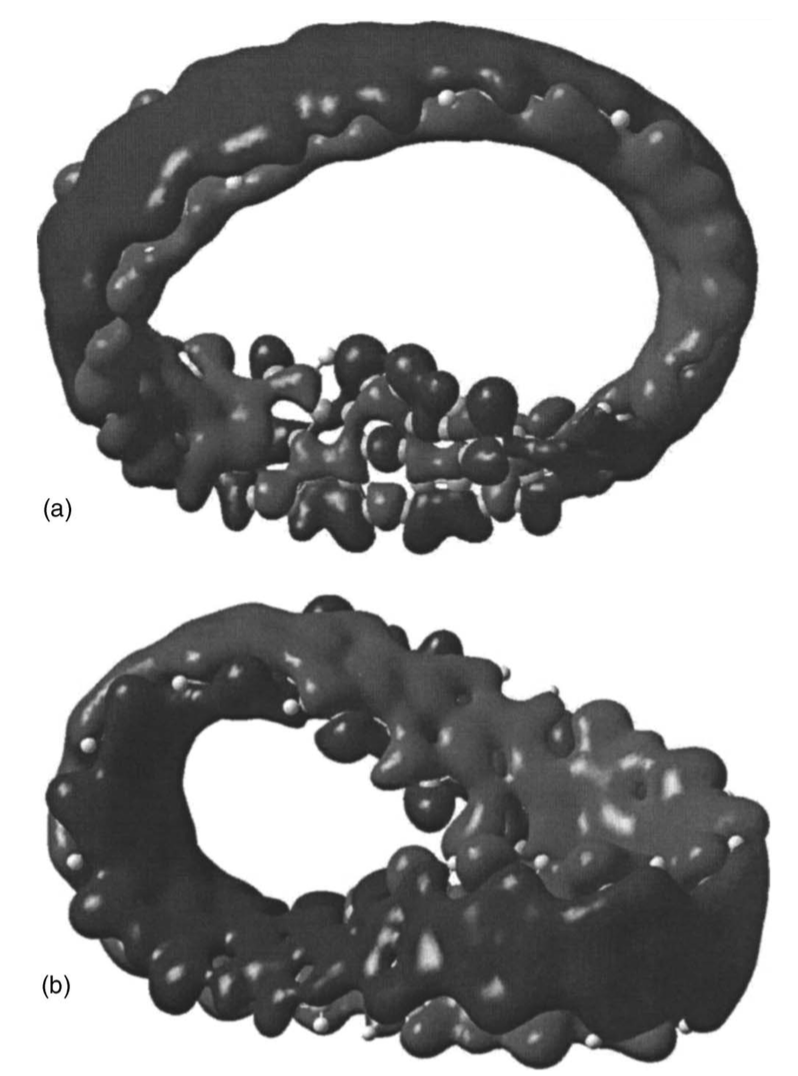1.
E. W. S.; Freire Caetano, V. N. ; dos Santos
Mobius and twisted graphene nanoribbons: Stability, geometry, and electronic properties Journal Article
In: THE JOURNAL OF CHEMICAL PHYSICS, vol. 128, pp. 164719, 2008.
@article{Caetano2008,
title = {Mobius and twisted graphene nanoribbons: Stability, geometry, and electronic properties},
author = {Caetano, E. W. S.; Freire, V. N.; dos Santos, S. G.; Galvao, D. S.,and Sato, F.},
url = {http://scitation.aip.org/content/aip/journal/jcp/128/16/10.1063/1.2908739},
year = {2008},
date = {2008-04-29},
journal = {THE JOURNAL OF CHEMICAL PHYSICS},
volume = {128},
pages = {164719},
abstract = {Results of classical force field geometry optimizations for twisted graphenenanoribbons with a number of twists Nt varying from 0 to 7 (the case Nt=1 corresponds to a half-twist Möbius nanoribbon) are presented in this work. Their structural stability was investigated using the Brenner reactive force field. The best classical molecular geometries were used as input for semiempirical calculations, from which the electronic properties (energy levels, HOMO, LUMO orbitals) were computed for each structure. CI wavefunctions were also calculated in the complete active space framework taking into account eigenstates from HOMO−4 to LUMO+4, as well as the oscillator strengths corresponding to the first optical transitions in the UV-VIS range. The lowest energy molecules were found less symmetric than initial configurations, and the HOMO-LUMO energy gaps are larger than the value found for the nanographene used to build them due to electronic localization effects created by the twisting. A high number of twists leads to a sharp increase of the HOMO→LUMO transition energy. We suggest that some twisted nanoribbons could form crystals stabilized by dipolar interactions.},
keywords = {},
pubstate = {published},
tppubtype = {article}
}
Results of classical force field geometry optimizations for twisted graphenenanoribbons with a number of twists Nt varying from 0 to 7 (the case Nt=1 corresponds to a half-twist Möbius nanoribbon) are presented in this work. Their structural stability was investigated using the Brenner reactive force field. The best classical molecular geometries were used as input for semiempirical calculations, from which the electronic properties (energy levels, HOMO, LUMO orbitals) were computed for each structure. CI wavefunctions were also calculated in the complete active space framework taking into account eigenstates from HOMO−4 to LUMO+4, as well as the oscillator strengths corresponding to the first optical transitions in the UV-VIS range. The lowest energy molecules were found less symmetric than initial configurations, and the HOMO-LUMO energy gaps are larger than the value found for the nanographene used to build them due to electronic localization effects created by the twisting. A high number of twists leads to a sharp increase of the HOMO→LUMO transition energy. We suggest that some twisted nanoribbons could form crystals stabilized by dipolar interactions.
2008
1.

E. W. S.; Freire Caetano, V. N. ; dos Santos
Mobius and twisted graphene nanoribbons: Stability, geometry, and electronic properties Journal Article
In: THE JOURNAL OF CHEMICAL PHYSICS, vol. 128, pp. 164719, 2008.
Abstract | Links | BibTeX | Tags: DFT, Graphene, Mobis, NanoRibbons, Structure
@article{Caetano2008,
title = {Mobius and twisted graphene nanoribbons: Stability, geometry, and electronic properties},
author = {Caetano, E. W. S.; Freire, V. N.; dos Santos, S. G.; Galvao, D. S.,and Sato, F.},
url = {http://scitation.aip.org/content/aip/journal/jcp/128/16/10.1063/1.2908739},
year = {2008},
date = {2008-04-29},
journal = {THE JOURNAL OF CHEMICAL PHYSICS},
volume = {128},
pages = {164719},
abstract = {Results of classical force field geometry optimizations for twisted graphenenanoribbons with a number of twists Nt varying from 0 to 7 (the case Nt=1 corresponds to a half-twist Möbius nanoribbon) are presented in this work. Their structural stability was investigated using the Brenner reactive force field. The best classical molecular geometries were used as input for semiempirical calculations, from which the electronic properties (energy levels, HOMO, LUMO orbitals) were computed for each structure. CI wavefunctions were also calculated in the complete active space framework taking into account eigenstates from HOMO−4 to LUMO+4, as well as the oscillator strengths corresponding to the first optical transitions in the UV-VIS range. The lowest energy molecules were found less symmetric than initial configurations, and the HOMO-LUMO energy gaps are larger than the value found for the nanographene used to build them due to electronic localization effects created by the twisting. A high number of twists leads to a sharp increase of the HOMO→LUMO transition energy. We suggest that some twisted nanoribbons could form crystals stabilized by dipolar interactions.},
keywords = {DFT, Graphene, Mobis, NanoRibbons, Structure},
pubstate = {published},
tppubtype = {article}
}
Results of classical force field geometry optimizations for twisted graphenenanoribbons with a number of twists Nt varying from 0 to 7 (the case Nt=1 corresponds to a half-twist Möbius nanoribbon) are presented in this work. Their structural stability was investigated using the Brenner reactive force field. The best classical molecular geometries were used as input for semiempirical calculations, from which the electronic properties (energy levels, HOMO, LUMO orbitals) were computed for each structure. CI wavefunctions were also calculated in the complete active space framework taking into account eigenstates from HOMO−4 to LUMO+4, as well as the oscillator strengths corresponding to the first optical transitions in the UV-VIS range. The lowest energy molecules were found less symmetric than initial configurations, and the HOMO-LUMO energy gaps are larger than the value found for the nanographene used to build them due to electronic localization effects created by the twisting. A high number of twists leads to a sharp increase of the HOMO→LUMO transition energy. We suggest that some twisted nanoribbons could form crystals stabilized by dipolar interactions.
http://scholar.google.com/citations?hl=en&user=95SvbM8AAAAJ


